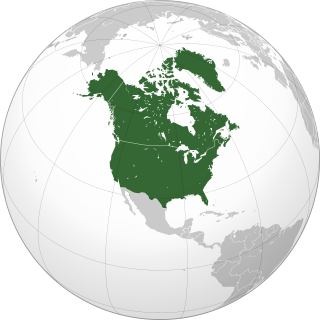Northern America
Northernmost subregion of North America From Wikipedia, the free encyclopedia
Northern America is the northernmost subregion of North America, as well as the northernmost region in the Americas. The boundaries may be drawn significantly differently depending on the source of the definition. In one definition, it lies directly north of Middle America.[2] Northern America's land frontier with the rest of North America then coincides with the Mexico–United States border. Geopolitically, according to the United Nations' scheme of geographical regions and subregions, Northern America consists of Bermuda, Canada, Greenland, Saint Pierre and Miquelon and the United States (the contiguous United States and Alaska only, excluding Hawaii, Navassa Island, Puerto Rico, the United States Virgin Islands, and other minor U.S. Pacific territories).[3][4]
 | |
| Area | 21,780,142 km2 (8,409,360 sq mi) |
|---|---|
| Population | 375,278,947 (2021 est.) |
| Population density | 16.5/km2 (42.7/sq mi) |
| GDP (nominal) | $27.5 trillion (2022)[1] |
| Countries | |
| Dependencies | |
| Languages | English, French, Spanish, Danish, Greenlandic, and various recognized regional languages |
| Time zones | UTC−10:00 (west Aleutians) to UTC+00:00 (Danmarkshavn, Greenland) |
| Largest cities | |
| UN M49 code | 021 – Northern America003 – North America019 – Americas001 – World |
Definitions
Maps using the term Northern America date back to 1755, when the region was occupied by France, Great Britain, and Spain.[5] The Solemn Act of the Declaration of Independence of Northern America in 1813 applied to Mexico. Today, Northern America includes the Canada–US dyad, developed countries that exhibit very high Human Development Indexes and intense economic integration while sharing many socioeconomic characteristics.[6]
The World Geographical Scheme for Recording Plant Distributions has "Northern America" as the seventh of its nine "botanical continents". Its definition differs from the usual political one: Mexico is included, Bermuda is excluded (being placed in the Caribbean region), Hawaii is excluded (being placed in the Pacific botanical continent) and all of the Aleutian Islands, Russian as well as American, are included.[7]
Countries and territories
| Country / Territory | Population[8][9] | Area (km2)[10] |
Density (people per km2) |
Capital |
|---|---|---|---|---|
| 64,185 | 53.2 | 1,206.48 | Hamilton | |
| 38,155,012 | 9,984,670 | 3.82 | Ottawa | |
| 56,243 | 2,166,086 | 0.03 | Nuuk | |
| 5,883 | 242 | 24.31 | Saint Pierre | |
| 336,997,624 | 9,826,675 | 34.29 | Washington, D.C. | |
* indicates "Demographics of country or territory" links.
Demographics
| Year | Population[12] | % change | Canada | % | United States | % |
|---|---|---|---|---|---|---|
| 1950 | 172,603,000 | — | 13,733,000 | 8.0% | 158,804,000 | 92.0% |
| 1960 | 204,649,000 | +18.6% | 17,847,000 | 8.7% | 186,721,000 | 91.2% |
| 1970 | 230,992,000 | +12.9% | 21,374,000 | 9.3% | 209,513,000 | 90.7% |
| 1980 | 254,007,000 | +10.0% | 24,417,000 | 9.6% | 229,476,000 | 90.3% |
| 1990 | 279,785,000 | +10.1% | 27,541,000 | 9.8% | 252,120,000 | 90.1% |
| 2000 | 312,427,000 | +11.7% | 30,588,000 | 9.8% | 281,711,000 | 90.2% |
| 2010 | 343,287,000 | +9.9% | 34,148,000 | 9.9% | 309,011,000 | 90.0% |
| 2020 | 368,870,000 | +7.5% | 37,742,000 | 10.2% | 331,003,000 | 89.7% |
See also
References
External links
Wikiwand - on
Seamless Wikipedia browsing. On steroids.
